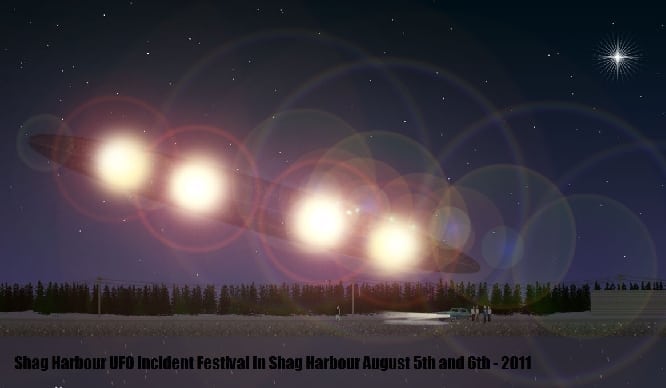If there are intelligent beings on planets so far away that we haven’t discovered them yet and they are watching us, then their technology must be far more advanced than ours. So forget those saucer-shaped tin cans people kept photographing during the 1950s and 60s, as they clearly couldn’t have travelled that kind of distance.
Even so, it does lead you to wonder where minds immeasurably greater than our own would hide an observation post to keep a closer eye on us human beings.
It occurred to me that, following the first lunar landing (assuming you believe Neil Armstrong walked on the moon in 1969), we have a pretty good understanding of everything within 240,000 miles of our planet, and obviously, thanks to the Hubble Telescope, way beyond, but we still know very little about things that are right under our noses.
Consider the oceans, for example. The furthest-reaching submarine was the remote-controlled Japanese Kaiko surveillance sub, an unmanned craft designed for deep-sea observation. The Kaiko could reach depths of nearly 38,000 feet, which sounds impressive initially until you work out that comes to a grand total of just under six miles.
 So we can see, thanks to the Hubble Telescope, a distance of between thirteen and fourteen billion light years upwards, but only six miles downwards.
So we can see, thanks to the Hubble Telescope, a distance of between thirteen and fourteen billion light years upwards, but only six miles downwards.
Now, we already know that unless you are Bigfoot or the Loch Ness Monster there is nowhere on earth to escape the long reach of satellites or modern radar systems so, if I were an alien capable of travelling thirteen billion light years to come and spy on us, I would also be clever enough to set up home underwater, happy in the knowledge that nobody would find me. Better still, directly underneath one of the polar ice caps.
So that led me to research unidentified submersible objects, the deep-sea version of UFOs. My attention was quickly drawn to a small port on the southern coastline of Nova Scotia in eastern Canada. But I’d like to point out that this had absolutely nothing to do with its name. Shag Harbor is normally a very quiet place but on 4 October 1967 it suddenly became a hive of activity.
At 11.20 p.m. a group of eleven people watched as a low-flying object suddenly veered downwards at an angle of forty-five degrees and plunged into the water. Some reported a bright flash of light as it hit the surface, while others claimed they saw four or five glowing orange lights.
Laurie Wickens, a Shag Harbor native, jumped on to the harbour wall to get a better view and said he saw the UFO floating on the surface with a strange orange light glowing on top of it.
Believing it was an aeroplane crash, residents immediately called in the Canadian Mounted Police who were then joined by the US military, suspiciously quickly. Within half an hour, local fishermen had put together a civilian rescue team and were already at the scene of the accident.
But they were puzzled to see no signs of any debris, wreckage, oil or bodies – only a large patch of foaming yellow bubbles. When one of the men attempted to take a sample by dipping his net into the water, the bubbles failed to attach themselves and the net always came up clean.
By the following afternoon, the authorities were satisfied that no aircraft had been reported missing and the area was sealed off while divers combed the area for clues. The official report of the incident revealed nothing, although it was later leaked that a second, identical craft had soon joined the first under the water and that, after a short delay, they both rose to the surface and zoomed away.
Thirty years later, one of the navy divers, interviewed for a television documentary, claimed the US military had monitored the two USOs for several days before losing contact with them.
To this day nobody knows what happened at Shag Harbor, although the sheer number of witness statements – all consistent in timing and in their descriptions of the size, colour and speed of the craft, coupled with the evidence of the yellow foam observed by most of the initial rescue team – would appear to provide credible evidence of a kind of underwater USO activity that had never been seriously considered before.
And the events at Shag Harbor are by no means the only sightings. During the prolonged Cold War (which followed the very hot Second World War), many submarine commanders reported tracking mystery underwater vessels, often in Norway and other Scandinavian countries, that, when cornered in one of the fjords, would mysteriously vanish.
On 4 September 1957, the Daily Telegraph reported that three uniformed police officers had witnessed a red, circular USO emerging from the depths of the Bristol Channel and taking a westerly route towards Wales. In the Lake District many sightings of USOs have been reported since the 1980s and on one occasion during 1994 twenty-two people reported observing two underwater craft at Derwent Water for five minutes before these disappeared without trace.
The Lakes now receive as many as one sighting every year, the latest being in December 2004, leading to suggestions that beings from outer space have set up an observation post beneath their tranquil waters.
One sighting in 1977 was independently confirmed by no fewer than ten policemen. Soon after midnight, on 28 August, officers claim to have witnessed a large diamond- or triangular-shaped object close to Lake Windermere, the largest natural lake in England. PC David Wild was the first to spot the strange craft and he watched it hover above the A592 at 1,500 feet for twenty-five minutes before it vanished before his very eyes.
Two other officers also witnessed the same phenomenon some distance away and John Platt described seeing what looked like a ‘massive sea-going catamaran with two hulls’, adding that the ‘surface was a dull, charcoal colour and giant lights were mounted on the front’. Which sounds exactly like a catamaran with headlights to me.
But despite Windermere being such a vast body of water, it is only 220 feet deep – hardly the best place in the world to hide a colony of aliens.
 More recently, the Dutch submarine Bruinvis (yes, the Dutch do have submarines) reported an underwater collision with a ‘solid object’ on 19 October 2001. Most of the crew clearly heard the noise and the sub limped back into port for emergency repairs.
More recently, the Dutch submarine Bruinvis (yes, the Dutch do have submarines) reported an underwater collision with a ‘solid object’ on 19 October 2001. Most of the crew clearly heard the noise and the sub limped back into port for emergency repairs.
Navy divers later confirmed damage to the underside of the vessel. But it was in August of the previous year, in the same stretch of waters off the Norwegian coastline, that one of the world’s worst submarine disasters took place, the sinking of the Russian vessel the Kursk. Could it have been involved in a collision with a USO?
The Kursk, flagship submarine of the Russian Northern Fleet, was proudly launched in 1995. But less than five years later, the world held its breath when the Russian authorities announced that an accident had caused the submarine – with 118 men on board – to sink to the bottom of the ocean.
One team of rescuers reported that major damage to the front section had rendered the escape hatch useless, but that there were also deep gashes along the side to the fin at the rear, suggesting the cause of the accident had not been an explosion, as was first though, but a collision with an unidentified object. But neither the US nor the Royal Navy, who also had submarines in the area, were able to report a collision with any of their own craft.
Furthermore, the Kursk’s periscope and external masts were fully extended, suggesting that the submarine had been operating within ten metres of the surface when it was struck as these sections of the vessel are always fully retracted, even during emergency dives, in deeper water.
Who can forget the rescue team’s harrowing reports of the hammering made by the surviving sailors as they tried in vain to save them? The subsequent salvage operation revealed that at least twenty-three men had remained alive for many days in the dark and cold, hoping for a rescue that never materialized.
When the craft was eventually brought to the surface, it was revealed that a neat circular hole had been punched into the side, unlike the damage made by a torpedo or collision with another submarine, and the front section was almost completely torn away.
To this day nobody knows what collided with the Kursk, although the rescue teams later described some green and white marker buoys bobbing on the surface that then mysteriously disappeared. (The buoys are used for alerting passing vessels or aircraft that an accident has occurred; Russian vessels only use red and white rescue buoys, however.)
Russian sources later confirmed that when the Kursk was eventually located there was a second, large, object lying next to it on the seabed, which slowly moved away and then disappeared altogether. For weeks afterwards, Russian attack submarines and warships of the Northern Fleet closely guarded the entire area. But whatever it was that sank the Kursk, with the loss of 118 lives, remains unknown to this day.
And it’s not just in northern waters. The Japanese deep-sea submersible the Kaiko mysteriously disappeared in May 2003 in the Pacific Ocean close to Japan after the steel cable attaching it the mother ship, the Kairei, inexplicably snapped, and it has never been seen since, leading to all kinds of speculation about mysterious forces lurking deep in our seas.
But I have the same problem with USOs that I have with all UFOs. If there are life forms from other galaxies that have found planet earth and discovered it inhabited by, in some areas, intelligent life, then why don’t they just land, shake hands and introduce themselves?
don’t they just land, shake hands and introduce themselves?
If we were to discover life on Venus, for example, would we buzz around their planet scaring the crap out of everybody living there? I doubt it very much; I expect we would do what the great adventurers of the past centuries have done when they discovered new lands.
And that is to introduce themselves politely to the natives and then steal all their diamonds and oil.They wouldn’t lurk around for decades first, would they? They’d wade straight in.
Unless of course, as I have long suspected, there is a vastly superior race out there somewhere who expelled the underclass of their own planet, (humans) onto another (earth) to stop us from breeding with their own kind. Casting humans out to a sort of penal colony for the stupid, on a faraway planet, may have been a good idea 100 million years ago.
Whilst their own race continued to advance at a rate immeasurably more superior to our own, we humans were left to interbreed and suffer the consequences. And every once in a while they send observers to make sure we remain at least 100 million more years behind them.
What? Why is that such a bad idea? It would explain evolution and it would explain why we have a planet full of stupid people. It would also explain periodic UFO sightings and perhaps even crop circles. Unless, of course, you still believe in all that God nonsense. But even then my explanation is no more ludicrous than yours – Is God a Spaceman?
Still, instead of labouring too hard over this problem, I think it may be time to pay a visit to Shag Harbor. Not to investigate any ongoing USO activities, but to find out why it is called that. – Albert Jack
Albert Jack AUDIOBOOKS available for download here
Albert Jack’s Mysterious World







































